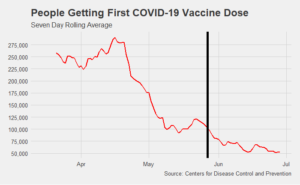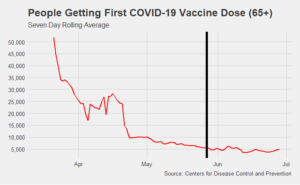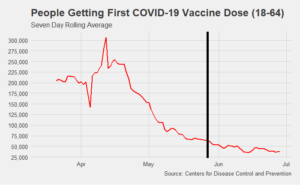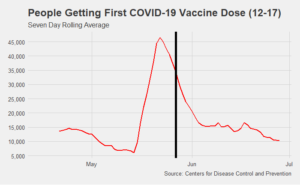How “Vax for the Win” became a huge loss
As the number of new people getting vaccinated in California has decreased over the past few months, Governor Gavin Newsom announced a new program, “Vax for the Win” to provide incentives to those who are on the fence about getting the shot. While Newsom was not the first governor to institute such programs (see Ohio), he has expanded the program to make it more and more like one of those classic game shows. He even appeared with cartoon characters at Universal Studios to celebrate the state reopening.
He started with three different prize programs. First, as an incentive for those who have not been vaccinated yet, starting on May 27, the following two million people who got vaccinated would receive a $50 prepaid or grocery card. Next were two lotteries in June. First was the “$50,000 Fridays” lottery, where 30 randomly selected vaccinated Californians would receive said amount of money. Then there was the big lottery on June 15, where ten randomly selected vaccinated Californians each received a $1.5 million grand prize.
But soon that was not enough. Newsom later introduced “California Dream Vacations” which will give six Californians vacations to either San Diego, Los Angeles, San Francisco, or Palm Springs. The winners will be announced on July 1. And (hopefully) finally, California partnered with Six Flags to give out 50,000 free tickets to people who get their vaccine starting June 16 from select vaccine providers.
But has “Vax for the Win” worked to encourage people to get vaccinated?
Chart 1

Chart 2

Chart 3

Chart 4

What actually happened
Looking at the number of people getting vaccinated according to the CDC in Chart 1, we can clearly see the impact of the program. May 27 was the announcement of the “Vax for the Win” program. In the chart, there has been a downward trend since April, and that trend continued after the program was introduced. In April, over 275,000 Californians got their first vaccine dose in one day. Today, we are just above 50,000 Californians getting their first dose today.
This is also the case with many age groups including the elderly (see Chart 2). Around 93% of all Californians 65 or older have now received at least one dose of the vaccine, according to the CDC.
It is also important to note that on May 12, Californians between the ages of 12 to 15 were allowed to receive a COVID-19 vaccine with their parents’ permission (with the exception of San Francisco, which allows teenagers to self-consent). This explains the huge rise in the number of 12-17 year olds getting vaccinated in late May in Chart 4, and the small blip in Chart 1.
How to know if the program worked
From a cost-benefit perspective, the number of people getting vaccinated should be higher than it would have been without the program for it to be deemed a success. If the number of people receiving the vaccine continued on the same trend, “Vax for the Win” would be a terrible failure. And, if more people do get vaccinated solely because of the program, the benefits (i.e. the high vaccination rate that would get us closer to herd immunity) needs to outweigh the costs.
To show why the program failed, we need to ask what the goal of the program was in the first place. There are two possible answers to this question that are related: (1) reducing COVID-19 deaths by protecting the elderly and vulnerable from the virus through vaccination, and (2) creating herd immunity by vaccinating a substantial number of the population. Both answers are not mutually exclusive, as you can try to achieve both, but the distinction is important. If for example, California vaccinated most of the state, but did not allow the vaccine to be given to the elderly or those with pre-existing conditions, the benefits of the program would be significantly less. So the goal of the vaccine program should be “to reduce the number of COVID-19 deaths in California, while concurrently create conditions for herd immunity.” So any COVID vaccine program should try to achieve both goals at the same time.
Problem 1- Giving money to people who were already planning/got vaccinated
As I have mentioned earlier, most elderly people have already received the vaccine. The remaining people left are relatively younger parts of the population who are generally healthier and might be more inclined to not immediately get the vaccine. Basically, Newsom is giving $50 and Six Flags tickets to healthy fifteen year olds whose parents were already planning on getting them vaccinated. But you may argue that herd immunity is worth the money being given, even if it is given to teenagers. This leads to the second problem.
Problem 2- Financial incentives are not the best motivator to get more people vaccinated
Financial incentives do not appear to be a major influencer in getting people to get vaccinated even those who are waiting according to a poll by the Kaiser Family Foundation in late May. The KFF found that only between 9-14% of those Americans that are waiting to get the vaccine were more likely to get the vaccine as the result of an incentive. And the term “more likely” does not equate to “will get vaccinated.” This means only a tiny part of the entire vaccine-eligible population would theoretically be influenced to get the vaccine as the result of this program.
What would motivate people to get the vaccine earlier? It is actually something outside of California’s control. The vaccines would need full approval by the FDA. About 44% of Americans who said they will “wait and see” about the vaccine were more likely to get it if it is fully approved. Just doing that would have saved California a lot of money, time, and effort.
Overall, this program failed to increase the number of people getting vaccinated, and unwisely spent a lot of money in order to influence a few Californians to get the vaccine. The next time Newsom hosts his “Wheel of Fortune” style lottery, hopefully his spin does not land on “Bankrupt.”
* * *
Brandon Ristoff is a policy analyst for the California Policy Center.
